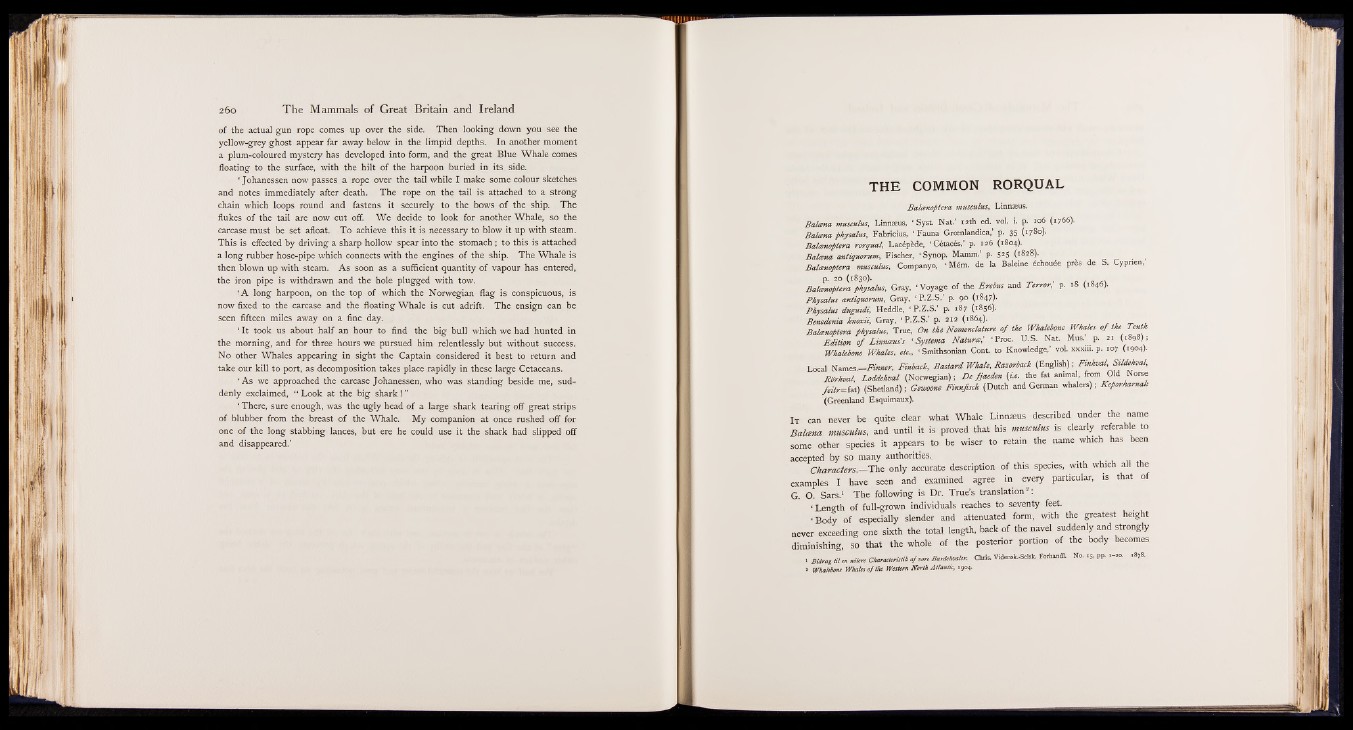
of the actual gun rope comes up over the side. Then looking down you see the
yellow-grey ghost appear far away below in the limpid depths. In another moment
a plum-coloured mystery has developed into form, and the great Blue Whale comes
floating to the surface, with the hilt of the harpoon buried in its side.
‘ Johanessen now passes a rope over the tail while I make some colour sketches
and notes immediately after death. The rope on the tail is attached to a strong
chain which loops round and fastens it securely to the bows of the ship. The
flukes of the tail are now cut off. We decide to look for another Whale, so the
carcase must be set afloat. To achieve this it is necessary to blow it up with steam.
This is effected by driving a sharp hollow spear into the stomach ; to this is attached
a long rubber hose-pipe which connects with the engines of the ship. The Whale is
then blown up with steam. As soon as a sufficient quantity of vapour has entered,
the iron pipe is withdrawn and the hole plugged with tow.
‘A long harpoon, on the top of which the Norwegian flag is conspicuous, is
now fixed to the carcase and the floating Whale is cut adrift. The ensign can be
seen fifteen miles away on a fine day.
‘ It took us about half an hour to find the big bull which we had hunted in
the morning, and for three hours we pursued him relentlessly but without success.
No other Whales appearing in sight the Captain considered it best to return and
take our kill to port, as decomposition takes place rapidly in these large Cetaceans.
‘ As we approached the carcase Johanessen, who was standing beside me, suddenly
exclaimed, “ Look at the big shark! ”
‘ There, sure enough, was the ugly head of a large shark tearing off great strips
of blubber from the breast of the Whale. My companion at once rushed off for
one of the long stabbing lances, but ere he could use it the shark had slipped off
and disappeared.’
THE COMMON RORQUAL
Baleenoptera musculus, Linnæus.
Baloena musculus, Linnæus, ‘ S y s t Nat.’ 12th ed. vol. i. p. 106 (1766).
BaUena physalus, Fabricius, ‘ Fauna Groenlandica,’ p. 35 ( i 78°)*
Baleenoptera rorqual, Lacépède, ‘ Cétacés,’ p. 126 (1804).
BaUena antiquorum, Fischer, ‘ Synop. Mamm.’ p. 525 (1828). f
Baleenoptera musculus, Companyo, ‘ Mém. de la Baleine échouée près de S. Cypnen,
p. 20 (1830).
Baleenoptera physalus, Gray, ‘ Voyage o f the E rebus and T erro r,' p. 18 (1846).
Physalus antiquorum, Gray, ‘ P.Z.S. p. 9° ( i 847)-
Physalus duguidi, Heddle, ‘ P .Z .S.’ p. 187 (1856).
Benedenia kn oxii, Gray, ‘ P .Z .S.’ p. 212 (1864).
Baleenoptera physalus, True, On the Nom enclature o f the Whalebone Whales o f the Tenth.
E d itio n o f Linneeus's ‘ Systema N a turee,' ‘ Proc. U.S . Nat. Mus.’ p. 21 (1898);
Whalebone Whales, etc., ‘ Smithsonian C on t to Knowledge,’ vol. xxxm. p. 107 (1904)-
Local Names._F in n er, Finback, B asta rd W hale, Razorback (English); F in hv a l, Sildehval,
Rörhval, Loddehval (Norwegian); D e fja ed en M the fat animal, from Old Norse
fe itr = fat) (Shetland) ; Gewoone F in n fsck (Dutch and German whalers) ; K eforkarnak
(Greenland Esquimaux).
It can never be quite clear what Whale Linnæus described under the name
Baloena musculus, and until it is proved that his musculus is clearly referable to
some other species it appears to be wiser to retain the name which has been
accepted by so many authorities..
C h a r a c t e r s .— The only accurate description of this, species,, with which all the
examples I have seen and examined agree in every particular, is that of
G. O. Sars.' The following is Dr. True’s translation8:
I Length of full-grown individuals reaches to seventy feet.
■ Body of especially slender and attenuated form, with the greatest height
never one sixth the total length, back of the navel suddenly and strongly
diminishing, so that the whole of the posterior portion of the body becomes
■ B U r a g H lr .m U r .C h .r^ r ü H h a fv o r .B .r i.k ^ r . Chris. Vidensk-Sdsk. ForhandL No. ,5, p p . - s o . .8,8.
» Whalebone Whales o f the Western North Atlantic, 1904.